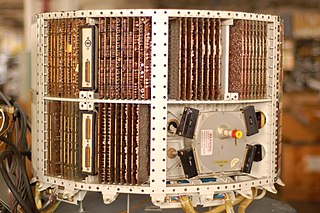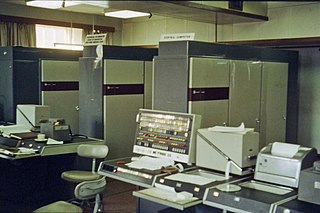Related Research Articles

The IBM 1620 was announced by IBM on October 21, 1959, and marketed as an inexpensive scientific computer. After a total production of about two thousand machines, it was withdrawn on November 19, 1970. Modified versions of the 1620 were used as the CPU of the IBM 1710 and IBM 1720 Industrial Process Control Systems.

The magnetic amplifier is an electromagnetic device for amplifying electrical signals. The magnetic amplifier was invented early in the 20th century, and was used as an alternative to vacuum tube amplifiers where robustness and high current capacity were required. World War II Germany perfected this type of amplifier, and it was used in the V-2 rocket. The magnetic amplifier was most prominent in power control and low-frequency signal applications from 1947 to about 1957, when the transistor began to supplant it. The magnetic amplifier has now been largely superseded by the transistor-based amplifier, except in a few safety critical, high-reliability or extremely demanding applications. Combinations of transistor and mag-amp techniques are still used.
KDF9 was an early British 48-bit computer designed and built by English Electric. The first machine came into service in 1964 and the last of 29 machines was decommissioned in 1980 at the National Physical Laboratory. The KDF9 was designed for, and used almost entirely in, the mathematical and scientific processing fields – in 1967, nine were in use in UK universities and technical colleges. The KDF8, developed in parallel, was aimed at commercial processing workloads.

Ferranti or Ferranti International PLC was a UK electrical engineering and equipment firm that operated for over a century from 1885 until it went bankrupt in 1993. The company was once a constituent of the FTSE 100 Index.

Titan was the prototype of the Atlas 2 computer developed by Ferranti and the University of Cambridge Mathematical Laboratory in Cambridge, England. It was designed starting in 1963, and in operation from 1964 to 1973.

Ferranti-Packard Ltd. was the Canadian division of Ferranti's global manufacturing empire, formed by the 1958 merger of Ferranti Electric and Packard Electric. For several years in the post-war era, the company underwent a dramatic expansion and had several brushes with success in the computer market, but eventually shed various divisions and returned to being an electrical grid supplier once again. The company was purchased in 1998 by the Austrian company, VA TECH. On July 23, 2005 Siemens PTD purchased VA Tech's Transmission and Distribution Division (T&D) group for transformers and switchgear.

International Computers and Tabulators or ICT was a British computer manufacturer, formed in 1959 by a merger of the British Tabulating Machine Company (BTM) and Powers-Samas. In 1963 it acquired the business computer divisions of Ferranti. It exported computers to many countries and in 1968 became part of International Computers Limited (ICL).

DATAR, short for Digital Automated Tracking and Resolving, was a pioneering computerized battlefield information system. DATAR combined the data from all of the sensors in a naval task force into a single "overall view" that was then transmitted back to all of the ships and displayed on plan-position indicators similar to radar displays. Commanders could then see information from everywhere, not just their own ship's sensors.

ReserVec was a computerized reservation system developed by Ferranti Canada for Trans-Canada Airlines in the late 1950s. It appears to be the first such system ever developed, predating the more famous SABRE system in the United States by about two years. Although Ferranti had high hopes that the system would be used by other airlines, no further sales were forthcoming and development of the system ended. Major portions of the transistor-based circuit design were put to good use in the Ferranti-Packard 6000 computer, which would later go on to see major sales in Europe as the ICT 1904.
The FP-6000 was a second-generation mainframe computer developed and built by Ferranti-Packard, the Canadian division of Ferranti, in the early 1960s. It is particularly notable for supporting multitasking, being one of the first commercial machines to do so. Only six FP-6000s were sold before the computer division of Ferranti-Packard was sold off by Ferranti's UK headquarters in 1963, the FP-6000 becoming the basis for the mid-range machines of the ICT 1900, which sold into the thousands in Europe.

The surface-barrier transistor is a type of transistor developed by Philco in 1953 as an improvement to the alloy-junction transistor and the earlier point-contact transistor. Like the modern Schottky transistor, it offered much higher speed than earlier transistors and used metal–semiconductor junctions, but unlike the schottky transistor, both junctions were metal–semiconductor junctions.

The D-17B (D17B) computer was used in the Minuteman I NS-1OQ missile guidance system. The complete guidance system contained a D-17B computer, the associated stable platform, and power supplies.
Ferranti's Argus computers were a line of industrial control computers offered from the 1960s into the 1980s. Originally designed for a military role, a re-packaged Argus was the first digital computer to be used to directly control an entire factory. They were widely used in a variety of roles in Europe, particularly in the UK, where a small number continue to serve as monitoring and control systems for nuclear reactors.

The Atlas Computer was one of the world's first supercomputers, in use from 1962 to 1972. Atlas' capacity promoted the saying that when it went offline, half of the United Kingdom's computer capacity was lost. It is notable for being the first machine with virtual memory using paging techniques; this approach quickly spread, and is now ubiquitous.
Teklogix International Inc., or Teklogix, was a tech company founded in 1967 by engineers working at Ferranti-Packard. The company focused on mini computer applications. It designed and built complete systems based upon DEC's PDP-8 computer, DEC's logic modules and purpose built logic. Many of the company's projects involved control of material handling systems and this led to the development of radio linked terminals for installation on fork lift trucks complete with multiplexers to interface to a variety of main frame computer systems.
Ferranti's Sirius was a small computer released in 1961. Designed to be used in smaller offices without a dedicated programming staff, the Sirius used decimal arithmetic instead of binary, supported Autocode to ease programming, was designed to fit behind a standard office desk, and ran on UK standard mains electricity with no need for cooling. It was also fairly slow, with instruction speeds around 4,000 operations per second, and had limited main memory based on delay lines, but as Ferranti pointed out, its price/performance ratio was difficult to beat.
Ferranti Canada's Route Reference Computer was the first computerized mail sorter system, delivered to the Canadian Post Office in January 1957. Despite a promising start and a great deal of international attention, spiraling costs and a change in government led to the project being canceled later that year. Technical developments pioneered for the Route Reference Computer were put to good use by Ferranti in several projects that followed over the next decade.
ICT 1900 was a family of mainframe computers released by International Computers and Tabulators (ICT) and later International Computers Limited (ICL) during the 1960s and 1970s. The 1900 series was notable for being one of the few non-American competitors to the IBM System/360, enjoying significant success in the European and British Commonwealth markets.

System Modules are a DEC modular digital logic family which preceded the later FLIP CHIPs. They connect to the units they are plugged into via a set of 22 gold-plated discrete pins along one edge.
References
Notes
- 1 2 3 4 5 6 7 Scarrott
- ↑ George Gray (December 1992). "The UNIVAC Solid State Computer". Unisys History Newsletter. 1 (2). Archived from the original on March 4, 2016.
- ↑ Bill Findlay, "The Hardware of the KDF9", 2009
- 1 2 Hall
- ↑ Barbara Ainsworth, "The Ferranti Sirius at Monash University" Archived 2009-10-20 at the Wayback Machine , Computer Resurrection, Number 44 (Autumn 2008)
- ↑ Ball & Vardalas, pg. 254
- ↑ Gribble
- 1 2 See "SOME KEY DATES", Group
- ↑ Maurice Gribble claims that his design was used for the basis of both the Orion 2 and the FP-6000. However, Ball and Vardalas state that the design was Canadian and quote one of the engineers to that end.(pg. 254)
- 1 2 System
- ↑ Campbell-Kelly, pg. 222
- ↑ Vardalas
- ↑ System, pg. 8
- 1 2 System, pg. 18
- ↑ System, pg. 16
- ↑ A. Rousell, "A progress report of NEBULA", The Computer Journal, Volume 5 Number 3 (1962), pg. 162-163
Bibliography
- (System), "Ferranti Orion Computer System", Ferranti, November 1960
- Norman Ball and John Vardalas, "Ferranti-Packard: Pioneers in Canadian Electrical Manufacturing", McGill-Queen's Press, 1994 ISBN 0-7735-0983-6
- Gordon Scarrott, "From Torsional Mode Delay Lines to DAP" [ permanent dead link ], Computer Resurrection, Number 12 (Summer 1995)
- Peter Hall, "A Management Perspective on Orion" Archived 2009-09-14 at the Wayback Machine , Computer Resurrection, Number 33 (Spring 2004)
- Maurice Gribble, "The Argus Computer and Process Control" Archived 2009-12-21 at the Wayback Machine , Computer Resurrection, Number 20 (Summer 1998)
- (Group), "Ferranti Orion 2 Contact Group: Report of Meeting at Storrington", 6 July 2004
- John Vardalas, "From DATAR To The FP-6000 Computer: Technological Change In A Canadian Industrial Context" Archived 2006-01-16 at the Wayback Machine , IEEE Annals of the History of Computing, Volume 16 Number 2 (1994)
- Martin Campbell-Kelly, "ICL: A Business and Technical History", Clarendon Press, 1989
Further reading
- "Orion Programmers' Reference Manual", Ferranti, 1961
- "The Ferranti ORION Computer System", contains numerous details and material on the Orion series
- Henry Goodman, "The Simulation of the Orion Time Sharing System on the Sirius", The Computer Bulletin, Volume 5 Number 2 (September 1961)